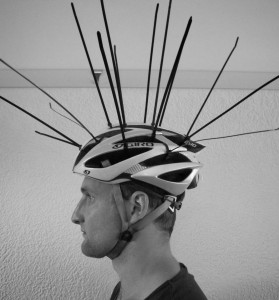How to survive the swooping bird season
 One of the major topics amongst my riding friends in the last few weeks at the post-ride café visit, has been aggressive birds. Spring has definitely sprung in my neighbourhood and birds are out in force defending their young.
One of the major topics amongst my riding friends in the last few weeks at the post-ride café visit, has been aggressive birds. Spring has definitely sprung in my neighbourhood and birds are out in force defending their young.
Thankfully my bird attacks have been uneventful where I’ve heard a click noise on my helmet and been aware of an anonymous object nearby, but a few of my friends have not been so lucky. One of them had a butcherbird attack him on Saturday morning and draw blood on his cheek. Another was attacked by an aggressive magpie last week while visiting an area where he doesn’t normally ride. Both of them stayed calm and managed to stay upright but many are not so lucky.
These stories have prompted me to do some research and put a list of facts and tips together.
Native birds such as Australian Magpies are highly protective of their eggs, nest and young and will often swoop at unsuspecting passers-by if they feel threatened. Other native Australian birds that are also common culprits include butcherbirds, kookaburras and plovers, but even invasive species like Indian Mynas can attack at this time of year.
Only a small proportion of birds swoop on people and these often have a preference for a few individuals that the birds recognise or certain types of ‘targets’ like cyclists. A magpie will only defend its nest within a ‘defence zone’. For cyclists, this is usually an area within 150 metres.
Almost all swoops on people are carried out by male birds defending their eggs and chicks, which are in the nest for about six to eight weeks between July and November. They will usually target the head but learn that helmets are there to protect the rider so start to side swoop attacking ears, cheeks and even eyes.
Most people get more injuries from falling off the bike or veering into oncoming traffic than the actual bird attack so it’s important to stay calm and keep riding.
Here’s a few tips that might help:
- Consider taking a different route if you know where a ‘swooping’ bird is nesting (from my experience this is pretty effective but not always practical)
- They generally only attack solo cyclists so ride in a tight bunch (once again not always practical because there’s always going to be a certain amount of riding when you’re on your own)
- Wear sunglasses to protect your eyes
- You may choose to dismount to avoid danger from traffic or from a fall. Once you have dismounted, look at the bird directly; magpies and other birds usually won’t attack when you are watching them
- Painting eyes on your helmet is not very effective as magpies have good eyesight and can learn the difference between painted and real eyes (plus it will look pretty silly at other times of year where there are no birds around)
- Putting cable ties on your helmet that stick up to deflect the swooping bird may or may not work. I’ve found no conclusive evidence in my research and frankly I’d rather take the risk than look like a dork.
PS. I borrowed this photograph from another blogger who was pointing out how ridiculous cable ties look attached to a helmet!!!!

A topic on the tip of my tongue after a ride filled with swooping yesterday I headed straight to the hardwear shop to stock up on cable ties only to take one look in the mirror and remove them.. Due to the dorky ness !!!
I’m glad it’s autumn over here… I’ve never heard of birds attacking cyclists before! That’s crazy. Almost as crazy as those cable ties.
I use cable ties, just two on the top and one on each side of my helmet (a magpie once ran its beak along my cheek under the rim of my helmet!) I cut the cable ties to about 4 cms so they don’t bend if the bird hits them. I find that the birds quickly realise it isn’t worth flying into a pointy object and leave me alone.